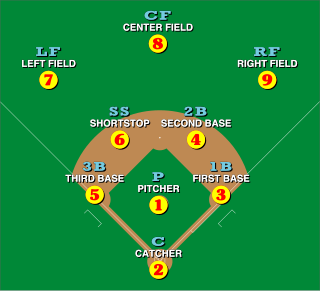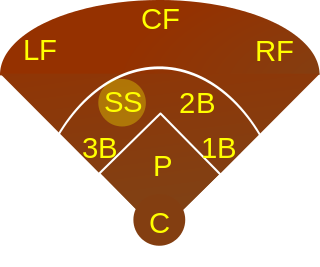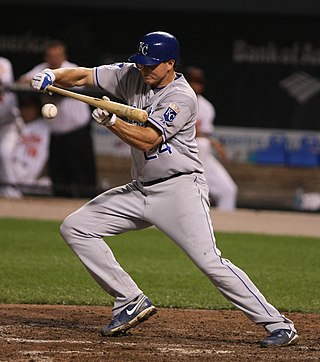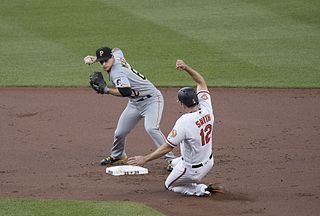This article needs additional citations for verification .(March 2023) |
An infielder is a baseball player stationed at one of four defensive "infield" positions on the baseball field, between first base and third base. [1]
This article needs additional citations for verification .(March 2023) |
An infielder is a baseball player stationed at one of four defensive "infield" positions on the baseball field, between first base and third base. [1]
In a game of baseball, two teams of nine players take turns playing offensive and defensive roles. Although there are many rules to baseball, in general the team playing offense tries to score runs by batting balls into the field that enable runners to make a complete circuit of the four bases. The team playing in the field tries to prevent runs by catching the ball before it hits the ground, by tagging runners with the ball while they are not touching a base, or by throwing the ball to first base before the batter who hit the ball can run from home plate to first base.
There are nine defensive positions on a baseball field. The part of the baseball field closest to the batter (shown in the diagram as light brown) is known as the "infield" (as opposed to the "outfield", the part of the field furthest from the batter, shown in the diagram as green.)
The infield is composed of four positions: first base (1B), second base (2B), third base (3B) and shortstop (SS). Generally, the first three have responsibility for plays at their respective bases, although the shortstop often shares responsibility for second base with the second baseman. Each position requires a different set of skills. A player who lacks the offensive or defensive skills needed to be a member of the starting lineup, but who has the various skills needed to play two or more infield positions competently and therefore can be called upon to come off the bench and fill a variety of defensive roles is called a utility infielder.
The second baseman and the shortstop are the middle infielders. The second baseman tries to field balls hit between first and second base. The shortstop does the same between second and third base. Once fielded, the balls must be thrown to the first baseman before the batter can reach first base. This requires speed to get to hit balls before they pass beyond reach, dexterity to successfully field the balls, and agility to field the balls in a position that will allow a strong throw to first base. Second basemen and shortstops also share responsibility for tagging runners who are attempting to steal second base. Because a shortstop has a longer throw to make to first base, he must reach the ball faster and throw harder than the second baseman. For this reason, the shortstop must have the best fielding skills of any infielder. Because of the spectrum of skills required by a middle infielder, emphasis is usually put on defensive skills rather than offensive ability—good defensive skills and a mediocre bat are often considered more important than a good bat and poor defensive skills.
The first baseman and the third baseman are the corner infielders.
The third baseman primarily fields balls hit and bunted down the third base line, but can also attempt to reach balls hit between second and third base. Although the third baseman does not need to cover as great a range as the shortstop or second baseman, the position requires greater anticipation and quicker reflexes, since the third baseman may be standing only 90 feet from the batter and sometimes much less; thus, he has much less time to react to hit balls than the shortstop or second baseman. The third baseman must also have a strong arm since the throw from his position to first base is the longest on the infield.
The first baseman is largely responsible for keeping one foot on first base while catching throws from the other three infielders before the batter can reach first base. These throws are often hurried and thus off-target. A player who is tall and has long arms may be a good candidate for first baseman because these attributes help him handle off-target throws. The first baseman must be able to cleanly field thrown balls that hit the ground before they reach first base, and to quickly decide to abandon first when necessary to catch an especially bad throw. Since the first baseman mostly stands close to his base, his mobility and throwing skills do not need to be high; good hitters who are slow of foot are often placed at first base. In some cases, an aging third baseman or outfielder who has lost some speed but is still a good hitter will be moved to first base to keep his bat in the line-up.

In the sport of baseball, each of the nine players on a team is assigned a particular fielding position when it is their turn to defend. Each position conventionally has an associated number, for use in scorekeeping by the official scorer: 1 (pitcher), 2 (catcher), 3, 4, 5, 6 (shortstop), 7, 8, and 9. Collectively, these positions are usually grouped into three groups: the outfield, the infield, and the battery. Traditionally, players within each group will often be more able to exchange positions easily ; however, the pitcher and catcher are highly specialized positions and rarely will play at other positions.

Softball is a game similar to baseball played with a larger ball on a smaller field, with only underhand pitches permitted. Softball is played competitively at club levels, the college level, and the professional level. The game was first created in 1887 in Chicago by George Hancock.

Shortstop, abbreviated SS, is the baseball or softball fielding position between second and third base, which is considered to be among the most demanding defensive positions. Historically the position was assigned to defensive specialists who were typically poor at batting and were often placed at the bottom of the batting order. Today, shortstops are often able to hit well and many are placed at the top of the lineup. In the numbering system used by scorers to record defensive plays, the shortstop is assigned the number 6.

A bunt is a batting technique in baseball or fastpitch softball. Official Baseball Rules define a bunt as follows: "A BUNT is a batted ball not swung at, but intentionally met with the bat and tapped slowly within the infield." To bunt, the batter loosely holds the bat in front of home plate and intentionally taps the ball into play. A properly executed bunt will create weak contact with the ball and/or strategically direct it, forcing the infielders to make a difficult defensive play to record an out.

In baseball and softball, a double play is the act of making two outs during the same continuous play. Double plays can occur any time there is at least one baserunner and fewer than two outs.

A third baseman, abbreviated 3B, is the player in baseball or softball whose responsibility is to defend the area nearest to third base — the third of four bases a baserunner must touch in succession to score a run. In the scoring system used to record defensive plays, the third baseman is assigned the number 5.

Catcher is a position in baseball and softball. When a batter takes their turn to hit, the catcher crouches behind home plate, in front of the (home) umpire, and receives the ball from the pitcher. In addition to this primary duty, the catcher is also called upon to master many other skills in order to field the position well. The role of the catcher is similar to that of the wicket-keeper in cricket.

In baseball and softball, second baseman, abbreviated 2B, is a fielding position in the infield, between second and first base. The second baseman often possesses quick hands and feet, needs the ability to get rid of the ball quickly, and must be able to make the pivot on a double play. In addition, second basemen are usually right-handed; only four left-handed throwing players have ever played second base in Major League Baseball since 1950. In the numbering system used to record defensive plays, the second baseman is assigned the number 4.

A first baseman, abbreviated 1B, is the player on a baseball or softball team who fields the area nearest first base, the first of four bases a baserunner must touch in succession to score a run. The first baseman is responsible for the majority of plays made at that base. In the numbering system used to record defensive plays, the first baseman is assigned the number 3.

The rules of baseball differ slightly from league to league, but in general share the same basic game play.
A hit and run is a high risk, high reward offensive strategy used in baseball. It uses a stolen base attempt to try to place the defending infielders out of position for an attempted base hit.

Baseball scorekeeping is the practice of recording the details of a baseball game as it unfolds. Professional baseball leagues hire official scorers to keep an official record of each game, but many fans keep score as well for their own enjoyment. Scorekeeping is usually done on a printed scorecard and, while official scorers must adhere precisely to one of the few different scorekeeping notations, most fans exercise some amount of creativity and adopt their own symbols and styles.
This is an alphabetical list of selected unofficial and specialized terms, phrases, and other jargon used in baseball, along with their definitions, including illustrative examples for many entries.
The wheel play is a defensive strategy in baseball designed to defend against a sacrifice bunt. The play's name derives from the wheel-like rotation of the infielders.